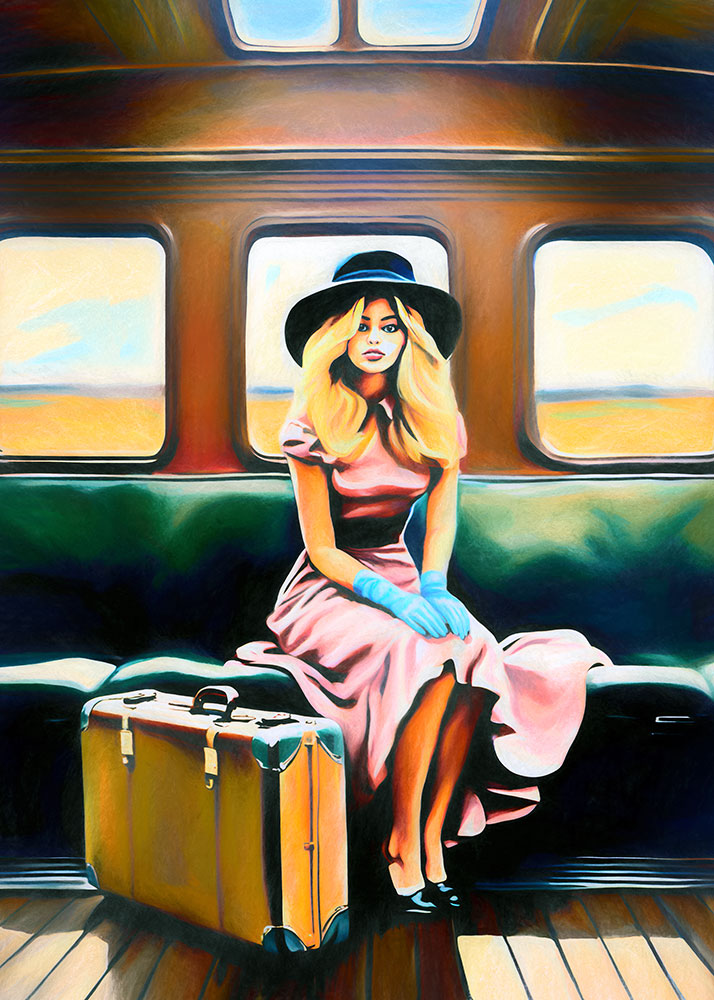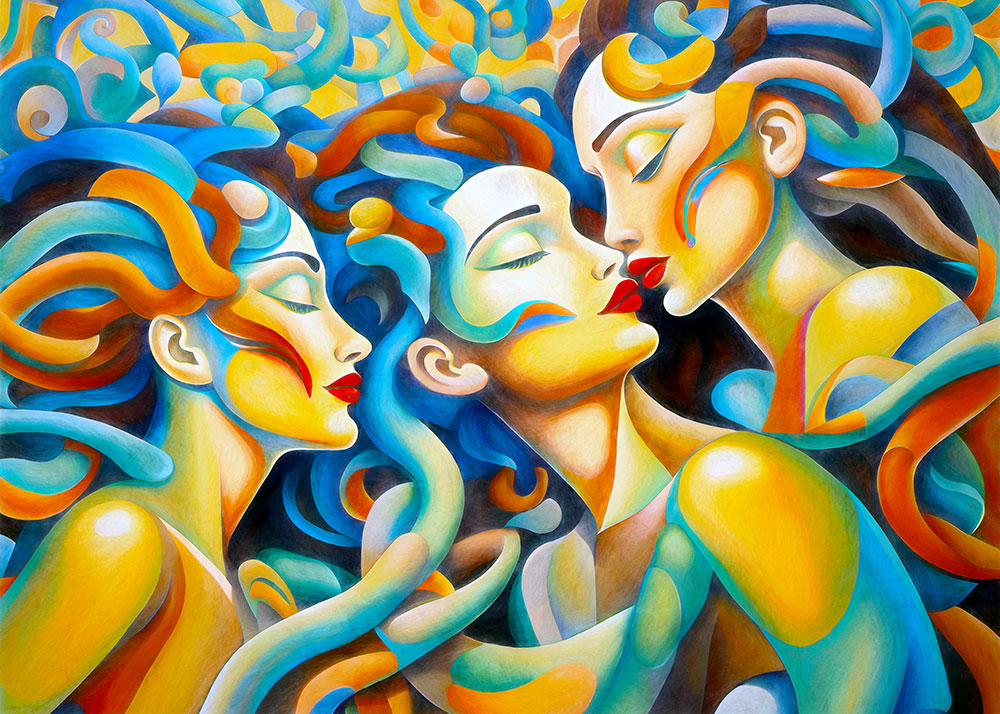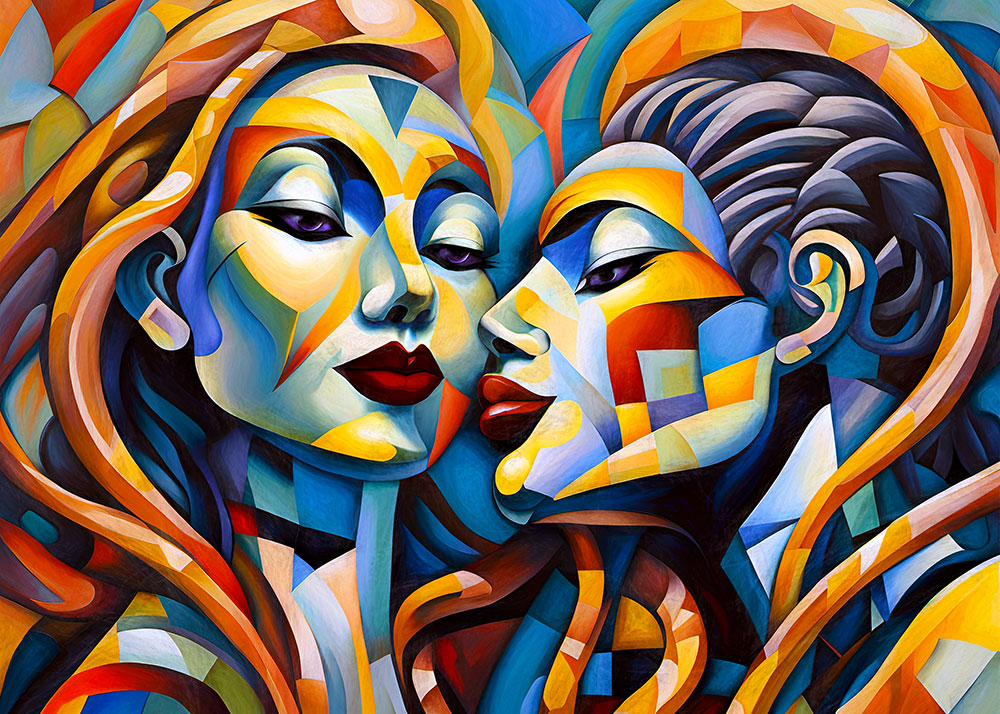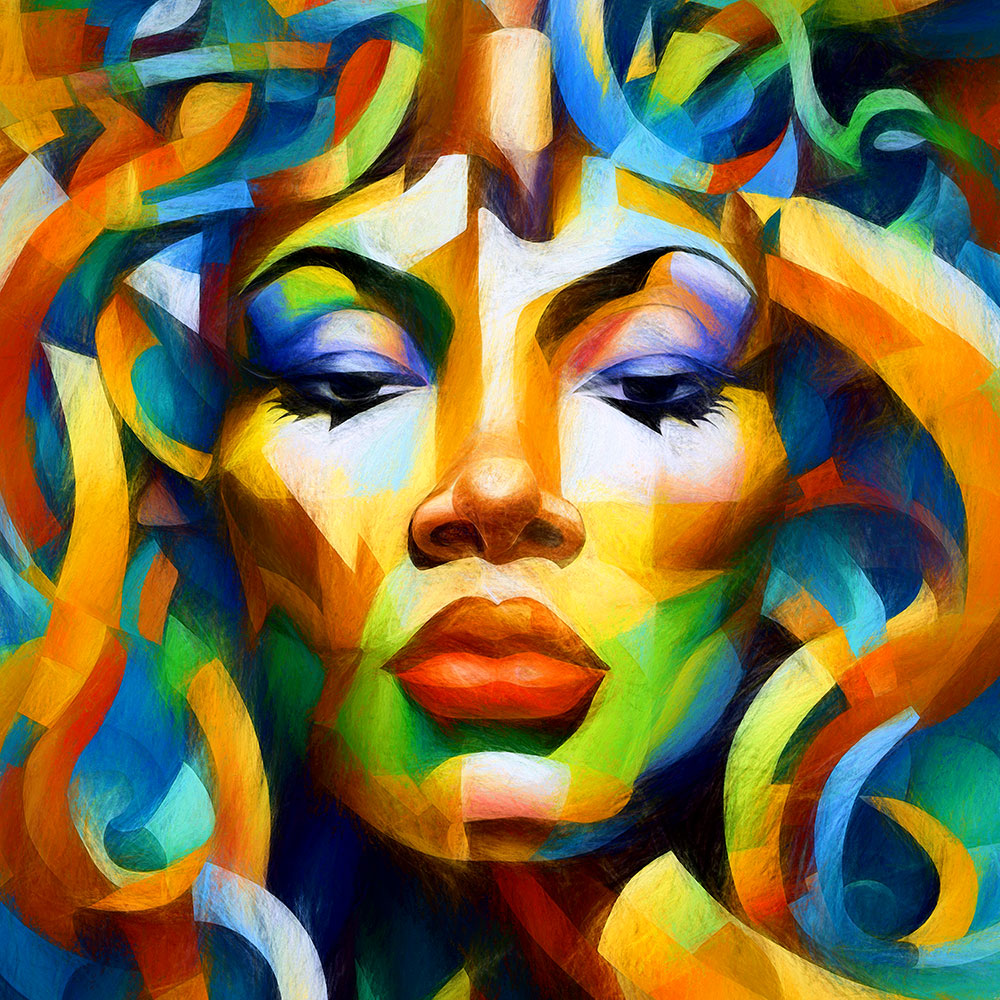Jacqueline Graciano Luna
Painter
Jacqueline Graciano Luna’s current work is a vivid exploration of emotion through the painted body. Using oils, watercolors, and expressive mark-making, she captures fleeting expressions, inner tension, and the quiet strength of feminine form. Her style is intuitive and intimate—rooted in personal history yet in dialogue with modernist influences. This gallery features her latest pieces, where color and gesture become language for what cannot be said aloud.

Compartment
Illustration by Jacqueline Graciano Luna
In Compartment, Jacqueline Graciano Luna conjures a charged moment of psychological tension—a tableau suspended in stillness. A young woman, perhaps seventeen or nineteen, is seated alone in a vintage train carriage evocative of the mid-20th century. The train, like the scene itself, is paused—caught in one of many prolonged and uncertain stops. Though the exterior world remains inaccessible, the interior is far from safe.
Rendered with a luminous sensitivity, the woman turns her gaze sharply toward the viewer—wide-eyed, alert, and unmistakably afraid. Someone has entered the space, and we, positioned in the intruder’s place, become both observer and participant. Luna offers no narrative certainty: Is the figure approaching a stranger, a man, a threat—or simply another anonymous passenger? The woman’s expression leaves us with only one truth: the acute and familiar fear of vulnerability in isolation.
With remarkable restraint, Luna explores the perceptual weight of public space as experienced by women—how beauty, youth, and solitude can shift from neutral to exposed in an instant. Compartment asks us not only to witness, but to interrogate our position within the image: What is our role in her story? Threat, bystander, protector—or something more ambiguous?
This work is not a depiction of violence, but of its possibility—of how danger resides not in what is seen, but in what might unfold. Through tonal subtlety and spatial economy, Compartment captures the pervasive unease of inhabiting a world where the female body is always subject to projection. It is a portrait of tension, not event; of presence, not escape.

The Watchers
Illustration by Jacqueline Graciano Luna
In The Watchers, Jacqueline Graciano Luna weaves myth, memory, and psychological stillness into a commanding tableau of feminine presence. Three women sit side by side, facing the viewer directly—unflinching, unsoftened, and entirely aware.
Their hair spills and coils around them with serpentine vitality, evoking the ancient specter of Medusa—not as a symbol of monstrosity, but as a powerful, misunderstood archetype reclaimed.
Each figure is individually rendered yet bound by a collective knowing—an emotional lineage carried not through expression but through posture, silence, and gaze. There is no fear here, no plea for empathy. Luna does not render victims; she renders witnesses.
With its formal balance and deliberate restraint, The Watchers reimagines classical myth through a contemporary feminist lens. The figures are not cursed—they are custodians: of memory, of rage, of untold histories that remain etched beneath the surface. The viewer may feel discomfort, reverence, or complicity—but they are seen, without question.
Luna’s long-standing fascination with Medusa lies not in her vilification, but in her transformation. What compels the artist is not the curse itself, but what it reveals: the societal fear of women who resist subjugation. In her visual language, Medusa is no longer a cautionary tale, but a vessel of unapologetic resilience—a figure shaped by violation, remembered only for her defense.
The Watchers stands not as a myth retold, but as an iconography of resistance: a quiet, sharpened strength that does not seek permission to exist, and will not look away.

The Moment Before
Illustration by Jacqueline Graciano Luna
In The Moment Before, Jacqueline Graciano Luna distills the emotional gravity of transition into a moment suspended in time. Executed in a restrained yet expressive cubist vocabulary, the illustration presents two women—fragmented in form but seamlessly intertwined in intent—leaning toward one another in a gesture that hovers between vulnerability and resolve.
This is not merely a depiction of intimacy; it is an exploration of decision as gesture. Through the interplay of angular composition and softened contours, Luna articulates the complex emotional terrain of two individuals poised at the threshold of self-actualization. Their embrace has not yet occurred, but the space between them is dense with meaning—pregnant with the weight of what has been resisted, and the freedom that awaits.
The illustration’s power lies in its restraint. Luna avoids spectacle, choosing instead to render the quiet intensity of a moment charged with consequence. In this tension, The Moment Before becomes an ode to queer love—not as performance, but as private revolution. It honors the courage it takes to move toward the life one wants, the body one desires, the truth one dares to claim.
By inviting the viewer into this intimate stillness, Luna does more than illustrate. She evokes memory, longing, and recognition—asking not just to be seen, but to be felt.

Her Gaze
Illustration by Jacqueline Graciano Luna
In Her Gaze, Jacqueline Graciano Luna reclaims the figure of Medusa from the confines of myth and repositions her as a potent icon of female agency.
Centered tightly within the frame, Medusa’s face is rendered with striking clarity and restraint—her expression calm, composed, and piercingly direct. There is no outcry, no performative anguish—only the unmistakable authority of a woman who sees, remembers, and will not be moved.
Luna deftly dissolves the spectacle surrounding Medusa and reveals a subject shaped not by monstrosity, but by survival. The serpents, often symbols of danger, are here recast as extensions of intuition—sentient, coiled guardians of experience and trauma. In Luna’s vision, Medusa is not inherently dangerous; she is dangerous because she has endured.
The work resists passive viewing. It implicates. The viewer is drawn into a confrontation—not with Medusa, but with their own gaze. Who is truly being observed?
Luna’s Medusa is no longer defined by what she has done, but by what has been done to her, and by the power she now commands on her own terms.
For Luna, Medusa is not merely a mythological subject, but a metaphorical construct—an embodiment of feminine power misread, misnamed, and ultimately unbound. Her Gaze is not a fall from grace; it is a precise and elegant rendering of sovereignty forged in silence, and of a gaze that no longer seeks permission to exist.
